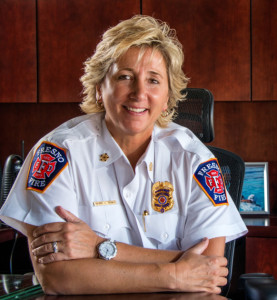By: Robert Avsec, Executive Fire Officer
Until a couple of days ago, I had no idea who Chief Kerri Donis was, but I sure do now. For my money, you can close

Fire Chief Kerri Donis, Fresno Fire Department
the nominations for Career Fire Chief of the Year for 2016. We have a winner.
I feel this way after watching and hearing Chief Donis discuss the recently released post-action investigation report for the March 2015 incident when Fresno Fire Captain Pete Dern fell through the roof over a garage fire and suffered 2nd and 3rd degree burns over 70 percent of his body (Thankfully, recent news reports have Captain Dern making continued progress in his long road to recovery).
Not since the release of the Firefighter Fatality Investigative Report (also known as the Phase II Routley report) following the Sofa Super Store fire in Charleston, South Carolina on June 18, 2007, has there been such an honestly brutal assessment of a fire service organization and its culture.
And the rest of us as well.
In the world of medicine, when a patient is experiencing a supra-ventricular heart rhythm (>220 beats per minute) their “pump” (their heart) is cavetating, to use a fire term. Left untreated, the patient will die because there’s no blood moving in their circulatory system (because the heart’s beating so fast, returning venous blood can’t enter).
Believe it or not, one of the accepted treatments is to have the patient immerse their face in ice-cold water. This stimulates the vagal nerve and can cause the heart to “reset” back to a normal life-sustaining rhythm (Having the patient “bear down” like they’re having a bowel movement is another method).
The fire service in the USA just had its “face” immersed in icy cold water.
Our collective inability to learn from the mistakes of others is our “supra-ventricular rhythm. The release of the document, Cortland Incident: Multi – Agency Serious Accident Review Team (S.A.R.T.) Investigation Report, by Chief Donis and the Fresno Fire Department was the icy water.
The report is also an indictment of the fire service in general and its lack of learning and changing as a result of history. “Lessons Learned” are not being transformed into “Behaviors Changed.”
See Related: Resistance to Change in the Fire Service
The Fresno investigation team reviewed and analyzed NIOSH Firefighter Fatality Investigation Reports (NIOSH Reports) over the past ten years for those reports that referenced interior structural firefighting. From that section of the report:
The items below are those that were found to be factors at the Cortland Incident that required recommendations by the SART. These same items were found and documented in the 70 (of 77) NIOSH Reports that were reviewed.
The number next to the item references how many NIOSH Reports the Item was documented in. This is another illustration of the fire service continuing to make the same mistakes over and over again.
Lessons Learned are not being converted into Behaviors Changed.
Our fire service culture continues to be in a “supra-ventricular rhythm” regarding safety and how we do the job we do. Oh, we’ve had Safety Week Stand-downs, safety symposiums, and now two sessions of the Firefighter Life Safety Summit, aka, “Tampa I and Tampa II.” But these “remedies” have not fixed the problem (Tampa I was held in 2004 and when Tampa II was convened ten years later, the participants were still talking about the same topics).
When will firefighters and officers get out of the “hurry, hurry, hurry” mentality described in the Fresno report? When will firefighters not wearing their personal protective equipment properly and on every call not be a safety issue? When will all firefighters wear their seatbelts every time the apparatus is moving? When will all fire officers effectively manage communications, control of resources, and the coordination of those resources using an Incident Action Plan? The list goes on and on.
How long will it take for our safety behaviors to really change?
See Related Articles
The Normalization of Deviance (Excellent article on fire service culture and behavior by John Dixon)
 Fire & EMS Leader Pro The job of old firefighters is to teach young firefighters how to become old firefighters!
Fire & EMS Leader Pro The job of old firefighters is to teach young firefighters how to become old firefighters!